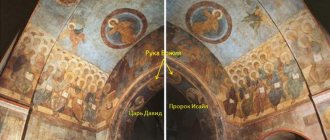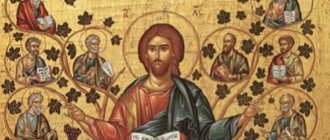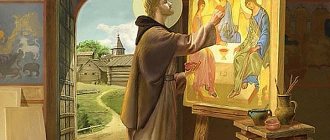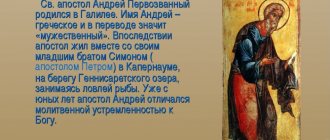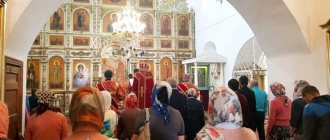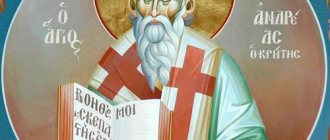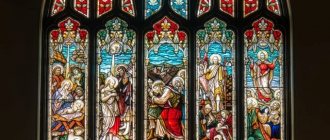Where is the icon?
This is one of the famous miraculous icons, which not only helps those praying before it, but is also a masterpiece of icon painting, a historical shrine. Many images of the Virgin Mary have been painted over the centuries. Her first icons, according to Holy Tradition, were created by the holy Apostle and Evangelist Luke, a doctor and icon painter. Based on them, many iconographies of the Mother of God appeared: each icon with a separate name has differences in the composition, the pose of the Mother of God or the Child, and their clothing. It was brought to Rus' after the yoke of Batu Khan, to Yaroslavl by the holy noble princes Vasily and Constantine.
The Yaroslavl Pechersk Icon of the Mother of God, whose feast day is May 27, is also known in Russia. She became famous in Yaroslavl at the end of the 19th century, when a miracle happened to a woman who had pain in all joints and was depressed - in great anguish for 17 years. She prayed a lot, asking the Mother of God for healing, and heard a voice in a dream with a command to find the icon of the Queen of Heaven in one church, where she would receive healing. She imagined a temple with an icon in it - and indeed, she was able to find a temple in her own city, it was right in the bishop's house - in the diocesan administration of Yaroslavl. The temple was dedicated to the Origin of the Honest Trees of the Life-Giving Cross of the Lord. Now this icon has been lost and the temple has been destroyed - all this during the revolution.
The Yaroslavl icon itself was under the arches of the stone Assumption Cathedral under the family icons, among which was the Yaroslavl one. Later, a temple under the Church of Elijah the Prophet, the most famous temple in Yaroslavl, was consecrated in honor of the icon. Therefore, the Temple of the Yaroslavl Icon of the Mother of God is under the Ilyinsky Church on Ilyinskaya Square in Yaroslavl.
There is also another Church of the Icon of the Yaroslavl Mother of God in Yaroslavl, it is located in the Sokol district on Frunze Street. Built in 2011. At the moment, the main scope of landscaping of the territory of the small church has been completed, work is underway on painting icons for the iconostasis. The great consecration of the temple was performed by Metropolitan Panteleimon of Yaroslavl and Rostov on November 30, 2011.
The history of the appearance of the holy face
The appearance of the icon dates back to the 13th century. According to art historians, she is the Russian version of Eleusa (Tenderness). In 1213, a cathedral was erected in Yaroslavl in honor of the Feast of the Dormition of the Blessed Virgin Mary. The icon of the Mother of God was in this cathedral for a long time, for which it received the name Yaroslavl.
Icon of the Mother of God "Yaroslavl"
In Orthodox Russia, this image of the Virgin Mary is considered one of the most ancient.
Important! The icon of the Mother of God and her Son was revealed by the Most Pure One during the difficult times of the Tatar-Mongol yoke for Rus'. She is characterized by special tenderness and depth of maternal feelings, as a symbol of intercession for the Christian race.
Ancient sources report that the icon was brought to Yaroslavl by the noble princes Vasily and Konstantin. Their reign occurred during the most brutal years, when the Tatar-Mongol hordes invaded Russian soil and destroyed everything in their path.
In 1238, a battle took place between Russian and Khan’s troops on the banks of the Sit River. After this, Prince Vasily, who miraculously survived the clash, inherited the Yaroslavl throne from his deceased father.
At the same time, the young prince and his brother Konstantin brought the miraculous image of the Mother of God of Tenderness to the city of Yaroslavl. The icon was placed in an ancient stone cathedral. The people, who were in fear and confusion from the devastating raids of the invaders, became stronger in spirit after the bringing of the icon of the Mother of God.
It is not known for certain where exactly the Holy Image was brought from. Presumably, the Yaroslavl icon was previously located in the city of Vladimir. But perhaps it was delivered from Kyiv. The legends say nothing about this. In the 15th-16th centuries, numerous copies were written from the icon, which were dispersed to different places.
Description of the icon
The Yaroslavl icon belongs to the type of Tenderness. It is easy to recognize images of this type by the fact that the Mother of God gently presses the Baby to Herself, hugging the Child, and the Baby Himself hugs the Mother.
The Holy Evangelist Luke wrote three main iconographic types of images of the Mother of God: Hodegetria (translated into Russian as Guide or Showing the Way), Eleussa (Merciful, Tender), and Oranta (Intercessor). Type Tenderness or Merciful. - when the Most Pure Virgin meekly, with mercy and pity for all people, looks at the one standing before Her. Type - these are icons united by one composition, clothing and pose of the Virgin Mary and the Infant God. It is easy to compare the image of the Yaroslavl Mother of God with an icon belonging to another type, Hodegetria, Smolensk or Tikhvin icon, in order to see the difference: the Mother of God is everywhere drawn from the waist up, but on the latter it is clear that the Child sits on the hand of the Mother of God, does not hug Her, but blesses those praying with his right hand and holds a scroll - a symbol of His destiny - in his left.
The Child Christ is to the right of the Mother of God, the faces of the Mother and the Son touch. An interesting and recognizable detail is that the Infant Christ holds the chin of the Most Holy Lady with his hand, while his legs are connected. According to legend, the Evangelist Luke painted 70 icons (most likely this is a legend). He painted from life - that is, the Mother of God Herself posed for the icons.
Magazine "Our Heritage" - History, Culture, Art
Alexey Fedorchuk
101 icons from Yaroslavl
No one doubted the high level of Yaroslavl icon painting in the 17th century, while later local icon painting was much less known until recently - primarily because most of the monuments were not restored. The opinion that at the beginning of the 18th century Yaroslavl was experiencing some kind of economic and cultural crisis was already expressed in the works of local historians at the turn of the 19th and 20th centuries. The researchers recalled that in 1713, by decree of Peter the Great, trade in some goods through Arkhangelsk was prohibited, and high duties were introduced for the rest. As a result of these innovations, the import and export of goods abroad began to be carried out mainly through the Baltic ports, and Yaroslavl, which was located on the ancient trade route that ran along the Volga and along the Arkhangelsk tract, lost a fair part of its income. The end of the “golden age” in the history of the city, in turn, could not but affect its culture. Without going into details, we note that these arguments presented the economic situation of Yaroslavl in Peter’s time with obvious simplification. But it was they who led to an obvious underestimation of Yaroslavl art of the 18th century.
Recently, the State Tretyakov Gallery hosted an exhibition dedicated to Yaroslavl icon painting of the 17th–18th centuries. Many of its exhibits have been restored over the past decade and for the first time became available to both specialists and a wide range of lovers of ancient Russian painting. The works presented at the exhibition made it possible to destroy the established stereotype and convincingly proved the continuity in the development of art in Yaroslavl throughout the 17th–18th centuries.
Yaroslavl icon painters of the 18th century carefully preserved the best achievements of their predecessors and enriched the style they developed, that is, a certain system of artistic techniques that made local icons easily recognizable. In the composition of icons, the Yaroslavl people preferred balanced, centric structures. The special monumentality of the images was combined with the artists’ passion for detail and an abundance of ornaments on clothes and architectural buildings. The coloring of the icons, although somewhat changing over time, retained bright color accents - including the bright red cinnabar and deep emerald green that were especially beloved by the Yaroslavl residents. The types of faces, patterns of features and color combinations used in personal writing were also quite stable.
The formation of local traditions of icon painting was facilitated by the very nature of the work of artists of the 17th century, most of whom came from the urban settlement. The most capable were assigned to the sovereign's Armory Chamber to participate in large artistic works at the royal court (for example, in the painting of the Assumption and Archangel Cathedrals of the Moscow Kremlin). Staying in the capital, fulfilling a responsible order as part of a single artel with leading masters from Moscow and other cities enriched the Yaroslavl residents with new artistic techniques and expanded their artistic horizons. From there, from the capital, artists brought new drawings—sample drawings that were used to create new works.
The artel method of work was practiced at this time not only in Moscow, but also in other cities, including Yaroslavl itself, where artels, consisting of local and visiting craftsmen, were involved in the painting of numerous churches and the creation of iconostases. In the artel, artists differed in their specialties: “znamenschik” - who created (“signified”) the drawing and, as a rule, performed the most important part of the image - the faces; “dolichnik” - one who wrote clothes; “herbalist” - who created ornaments, etc. This “division of labor” was used not only in monumental painting, but also in icon painting - for example, on the icon of Stepan Zavyazoshnikov “The Nativity of Christ” of 1786, in the loss of the author’s paint layer on the ground, letters-marks were visible, with which the artist apparently marked for the apprentice, the color of one or another detail of the image.
This organization of work in the icon-painting workshop brought together the individual creative style of the artists. The artels also established an apprenticeship system - the secrets of the artistic craft, as was customary in the Middle Ages, were inherited from teacher to student, most often from father to son. By the second half of the 17th century, dynasties of icon painters were emerging in Yaroslavl, many of whom worked successfully in the next century, during a period when the calls of provincial masters for government work in Moscow and St. Petersburg ceased. Thus, it was the presence in the city of hereditary artists who inherited the art traditions of an earlier time that largely ensured the stability of the local artistic style in the 18th century.
Local customers also contributed to the preservation of the stylistic unity of Yaroslavl icon painting. Unfortunately, not a single contract for the creation of icons has survived to this day. But if we proceed, for example, from the surviving contracts for the production of a carved gilded iconostasis, concluded by the parish of the Church of Elijah the Prophet in the 1690s, it becomes clear that the customer played an important role in determining both the appearance and style of the new work. Thus, in particular, these documents name particularly liked details in one of the earlier iconostases, which are proposed to be repeated. This focus on patterns also contributed to the preservation of traditions.
Innovations were introduced into the Yaroslavl icon very gradually. Of course, the concept of “new”, “modern”, “fashionable” in a certain context existed in the Middle Ages. Thus, already in the 17th century, non-resident artists were invited to Yaroslavl, whose works attracted the attention of customers. Among them were Kostroma resident Gury Nikitin, Ustyug resident Fedor Zubov, and Kholmogorsk resident Semyon Spiridonov. It is under their influence that Yaroslavl residents begin to paint more and more images in green and red tones, enriching the color of their works with colored varnishes and the finest gold ornaments.
Nevertheless, among the icon painters who came to the city, masters of a more archaic type predominated, inheriting in their work the techniques of the so-called Stroganov school at the turn of the 16th–17th centuries. The Stroganovites were famous for their honed craftsmanship, exquisite miniature painting and work using the gold-gold writing technique. They created icons that were more similar to works of jewelry, which should have especially appealed to wealthy Yaroslavl merchant customers. It seems that masters of the “live-like”, pro-Western orientation were not liked in Yaroslavl. New artistic techniques, due to the influence of Baroque and later classicism, appeared in local painting gradually, without violating the integrity of works traditional in spirit.
Along with complex multi-figure compositions, often executed using the technique of miniature writing, Yaroslavl icon painting created images that were monumental in form and, at the same time, quite expressive. The painting of monumental icons for wooden churches in the first half of the 17th century was probably due to the need to achieve maximum expressiveness and grandeur of church interiors with a small number of works. Yaroslavl residents could not afford a large number of icons during the restoration of the city after the Polish devastation. Among the best works of this time is the image of the Mother of God of Korsun, coming from the Church of Demetrius of Thessalonica.
By the middle of the 17th century, Yaroslavl reached the peak of its economic development. First, wealthy merchant families, and then individual parishes, began building stone churches. Already the earliest stone parish churches were very large, resembling city and monastery cathedrals in type. In such churches there should have been images commensurate with them in terms of the scale of perception - such as “Simeon the God-Receiver”, “Bringing the Apostle Peter out of prison”, “Elijah the Prophet in the Wilderness”, as well as icons with selected saints praying in front of the icons of the Great Savior Bishop and Our Lady of Tolga, and some others. The commitment to monumentality continued in Yaroslavl art in the 18th century, as evidenced by the “Our Lady of All Who Sorrow Joy”, “Savior the Great Bishop” and “Savior Not Made by Hands” presented at the exhibition.
Another direction of creative search by Yaroslavl artists involved the creation of icons in which the content was revealed in maximum detail in numerous miniature stamps. The particular prevalence of such images in the 17th century was predetermined by the tastes of the customers of the icons, whose roles in parish churches were most often trading people - merchants. Due to the nature of their occupation, they traveled a lot and received many new impressions, on the basis of which a new vision of the world gradually emerged - diverse and mobile, filled with people and events. This, in turn, could not but affect their aesthetic tastes and preferences.
Extended cycles of images in stamps were most often dedicated to the life of the saint represented in the center of the icon. These are the icons of the martyr Theodore Stratelates, St. John Chrysostom, St. Demetrius of Prilutsk, Catherine the Great Martyr, and the Evangelist Matthew. Icon painters loved to illustrate in stamps the texts of liturgical chants and prayers, as well as various legends, mainly about miraculous icons. Some of these icons were presented at the exhibition: “Praise of the Mother of God, with an akathist”, “Annunciation, with the “joys” of the Mother of God” and the image of the Mother of God of Vladimir with marks of miracles. A special group consists of frame icons, which were created when updating iconostasis for ancient shrines - in order to emphasize their significance. Thus, already in the middle of the 17th century, a frame with passion marks was made for the icon of the Savior Almighty. The frame of the “Our Lady of Yaroslavl” icon, a prayer image of the holy Yaroslavl princes Vasily and Constantine, located in the city’s Assumption Cathedral, dates back to the end of the 18th - beginning of the 19th centuries.
From the middle of the 17th century, icons in which individual scenes did not form a strict geometric series of marks, but were picturesquely arranged over the entire surface of the icon board, became widespread in Yaroslavl. Most often, a similar compositional principle was used in images of the Nativity of Christ. There are more than a dozen similar icons in the collection of the Yaroslavl Museum. The earliest of them, from the mid-17th century, and the later, executed in 1786 by Stepan Zavyazoshnikov, were presented at the exhibition.
The desire for monumental images and a special love for detail and entertaining plots led to the appearance in Yaroslavl of icons of a special type, combining a large monumental image of the saint with separate scenes-stamps, which were freely located on the background and on the ground. Perhaps one of the first to paint such icons was Ustyug resident Fyodor Evtikhiev Zubov, one of the leading masters of the Moscow Armory, invited by the Skripin merchants to work in the Church of Elijah the Prophet. At the exhibition at the Tretyakov Gallery, one of the few indisputable works of this master that has come down to us was exhibited - the icon “Ilya the Prophet in the Desert,” dated 1672.
The central image of Elijah seated on a stone is complemented by scenes from the life of the prophet, inscribed in the landscape background. The same technique twenty years later, in 1692, was used by the icon painter Andrei Savin (a native of the village of Velikoye) when painting the image of “Epiphany”. A similar compositional solution is present in the icon “St. John Chrysostom,” created by a Yaroslavl icon painter at the beginning of the 18th century. On its ground, on the sides of the figure of the saint, there are two marks with scenes of the birth of John Chrysostom and the transfer of his relics. Large figures of saints and small miniature stamps on the ground are combined with even greater grace and proportionality in the images of the first half of the 18th century - “Reverend Paul of Thebes and John Kushchnik, with scenes from their lives” and “Reverend Zosima and Savvaty of Solovetsky”.
An important achievement of the exhibition, in my opinion, was the demonstration of not only the stylistic unity, but also the iconographic diversity of Yaroslavl icons. Based on the set of subjects that have become widespread in local art, one can to some extent judge the worldview of the Yaroslavl people, their most important historical, cultural and spiritual guidelines.
From the beginning of the 17th century, images began to be painted in abundance in Yaroslavl, illustrating church chants. So, for example, in the church inventories of the 19th century that have reached us, almost every church mentions the icon “Rejoices in You.” The text of the hymn, which compared the Mother of God with the “sanctified church” and “verbal paradise,” allowed the artist to depict on such icons paradise with a host of saints praising the Mother of God, and the saints were depicted in strict accordance with the idea of the harmonious structure of the heavenly world - in strict rows, according to ranks: forefathers, prophets, apostles, saints, martyrs and reverend women. The image of the saints by rank was to be perceived as an image of all humanity living in unity, harmony and prayer. The plot of “He rejoices in You” could be so beloved by the people of Yaroslavl precisely because it reflected their ideas about the ideal, reasonable structure of the universe. It is interesting that the spread of this iconography on Yaroslavl soil begins in the 17th century, immediately after the events of the Time of Troubles, in which Yaroslavl had the opportunity to play such an important role.
In 1612, a militia came to the city from Nizhny Novgorod under the leadership of Prince Dmitry Pozharsky and the townsman Kozma Minin. In Yaroslavl, the “Council of the Whole Earth” was formed, to which all cities sent their representatives. Other bodies of state power were also created in Yaroslavl, including orders that directed individual territories and state affairs (such as, for example, the palace and monastery). Coins were minted here, ambassadors were sent to Austria from here and negotiations were conducted with the Swedes. Thus, the city actually served as the capital of the state for four months. The residents of Yaroslavl were able to see by their own example the difficulties of achieving unity and the need for agreement to overcome chaos and “unrest.” Perhaps it was from that time that the theme of conciliarity, a single prayerful presence, characteristic of Russian Orthodoxy as a whole, was developed especially widely in Yaroslavl art.
Numerous icons with images of selected saints, represented in prayer to one image or another, were also associated with this theme. Two of them, originating from the Yaroslavl Kazan Monastery, are extremely important for understanding the worldview of the Yaroslavl people at the end of the 17th century.
The icons are paired: one of them depicts the Moscow metropolitans Peter, Jonah, Alexey and Philip and blessed Vasily and Maxim in prayer to the image of the Great Savior Bishop, and on the other - the holy Yaroslavl princes Vasily and Konstantin, Feodor, David and Konstantin and the Venerable Macarius of Unzhensky praying to the image of the Mother of God of Tolga. There is clearly a specific program behind the selection of saints on the icons. The first one presents Moscow saints, patrons of the capital of the Russian state and the reigning Romanov dynasty. Between the figures of saints, a much lost image of a city has been preserved, in which the real buildings of the Moscow Kremlin can be discerned. The second icon depicts the holy Yaroslavl princes from the first dynasty - brothers Vasily and Konstantin - and the founder of the second Yaroslavl princely dynasty - the holy noble prince Fyodor Cherny (Smolensky) with his sons David and Konstantin. The princes offer their prayers to the Tolga Icon of the Mother of God, who, according to legend, appeared in 1314 and was revered as the protector and patroness of Yaroslavl.
It is interesting that, in addition to the Yaroslavl miracle workers, this icon represents the Kostroma venerable Macarius of Unzhensky, canonized under Mikhail Romanov in 1619 (in 1620, the Unzhensky monastery was visited by the king himself with his mother, nun Martha, on a pilgrimage, which was supposed to emphasize the all-Russian significance of the new cult ). Such a combination of saints on the Yaroslavl icon was probably meant to remind us that the Romanovs’ ascension to the royal throne, which began in Kostroma, was also connected with Yaroslavl and would hardly have been possible without the heroic efforts of local residents in 1612. Only awareness of the historical significance of one’s hometown and its services to the entire country could lead to the creation of such a work. It is curious that in the 19th century, during the renewal of the icons, their programmatic nature was not entirely clear to the master icon painter, as a result of which the holy Prince Alexander Nevsky and St. Mitrofan of Voronezh, patrons of the Russian Empire, were painted over the figures of the blessed, and the Venerable Macarius of Unzhensky was replaced by the saint Demetrius of Rostov, especially revered in the Yaroslavl diocese. Icons began to be perceived only as a comparison of the national and local cults of saints.
Another monument comes from the Kazan Monastery, which clearly reveals the peculiarities of the historical self-awareness of the Yaroslavl people. This is a frame painted at the end of the 17th century with picturesque marks from the miraculous Yaroslavl-Kazan Icon of the Mother of God. The central vertical of the frame is occupied by an image of the Holy Trinity and three marks with compositions glorifying the Virgin Mary. On the sides and at the top there are stamps telling about the discovery of the miraculous Kazan Icon of the Mother of God and the creation of a copy of it by order of Ivan the Terrible, as well as about numerous healings from the shrine. Four marks in the lower corners of the frame are dedicated to the history of the Yaroslavl-Kazan icon. According to the legend, an angel who appeared in a dream to a resident of the small Volga town of Romanov, Gerasim, who was ill with an “eye disease,” ordered him to go to the city of Kazan and there, in the icon row, exchange a copy from the famous shrine - the miraculous image of the Kazan Mother of God. Gerasim did so, after which, returning home, he took the icon to the St. Nicholas Church and began to persuade the Romanovites to build a new church for it. Residents of the town did not agree to this, and the icon remained in the St. Nicholas Church until 1609, when Romanov was captured by the Poles. One of the nobles took the icon of the Mother of God from the temple abandoned by the townspeople, and later, during the siege of Yaroslavl by the troops of False Dmitry II, he gave it to the Yaroslavl zemstvo elder Lytkin. The residents of Yaroslavl believed that the city was saved from the Polish capture by the shrine brought to the fortress, and in memory of the siege and the special patronage of the city by the Yaroslavl-Kazan Icon of the Mother of God, they subsequently founded the Kazan Monastery.
It is also noteworthy that in the marks of the frame made for the miraculous Yaroslavl icon, there is a visual comparison of two copies of the Kazan Icon - the Yaroslavl and the Moscow, commissioned by Ivan the Terrible. The miraculous Yaroslavl icon itself has not reached our time, and at the exhibition one of the early copies was inserted into its frame, differing from the original in the images of saints in the margins.
The tradition of performing repetition lists from ancient shrines can be traced throughout the history of Yaroslavl icon painting. Among such lists, the exhibition presented, first of all, images of the Mother of God: Korsunskaya, Vladimirskaya, Khlynovskaya, Bogolyubskaya, Kazanskaya. The famous local images also received special attention from Yaroslavl residents, including the temple icon of the Church of the Archangel Michael on Kotorosl, executed, according to legend, in 1299 by order of Princess Anna, the second wife of the Yaroslavl prince Fyodor the Black. The ancient icon is currently in the main exhibition of the State Tretyakov Gallery, and at the exhibition one could see a copy of it, made at the beginning of the 18th century. In the 18th century they wrote a lot of repetitions of the miraculous image of the Savior Not Made by Hands, which several times saved the city from pestilence. One of these lists, dated 1757, was also presented at the exhibition. The cult of local shrines is also associated with an 18th-century copy of a fresco depiction of the martyr Thomaida on the porch of the Yaroslavl Church of John the Baptist in Tolchkovskaya Sloboda. It is noteworthy that lists from such shrines were often ordered even for temples located in close proximity to the places where the miraculous images themselves resided. The presence of such a list in the temple was supposed to remind believers again and again that they were under heavenly protection and patronage.
The idea of divine patronage for Yaroslavl received its most consistent expression in the program of icon-frames for the miraculous image of the Mother of God of Yaroslavl, located in the Assumption Cathedral. It was written in 1803 by Ivan Smirnov. In the center of the frame are depicted the holy Yaroslavl princes Vasily and Konstantin, holding in their hands the icon of the Mother of God of Yaroslavl, which, according to legend, was their home prayer image. On the sides of the princes, in cartouches, are images of the most revered Mother of God icons of the Christian world and scenes of the miracles of the Mother of God. At the top of the frame are the Holy Trinity and the Mother of God, from which light emanates onto the globe (a hemisphere with two rivers, the Volga and the Yaroslavl Kotorosl), crowned with an image of the Yaroslavl Assumption Cathedral.
What does it help with?
Let us remind you that every icon that has its own name is miraculous. This means that through prayers to the Mother of God, miracles are performed through this icon, which are documented and recognized by the Church. Traditionally, people pray in front of different icons of the Mother of God in different circumstances, different everyday difficulties. Through this image, the Mother of God helps parents and children, as well as the sick and elderly, a lot. They also pray to the Mother of God in front of the icon
- When planning pregnancy;
- About healing infertility;
- On saving the child in case of threat of miscarriage;
- About overcoming psychological difficulties;
- About healing children, parents, adults.
Culture:
Recently, the State Tretyakov Gallery hosted an exhibition dedicated to Yaroslavl icon painting of the 17th–18th centuries. Many of its exhibits have been restored over the past decade and for the first time became available to both specialists and a wide range of lovers of ancient Russian painting. The works presented at the exhibition made it possible to destroy the established stereotype and convincingly proved the continuity in the development of art in Yaroslavl throughout the 17th–18th centuries.
Yaroslavl icon painters of the 18th century carefully preserved the best achievements of their predecessors and enriched the style they developed, that is, a certain system of artistic techniques that made local icons easily recognizable. In the composition of icons, the Yaroslavl people preferred balanced, centric structures. The special monumentality of the images was combined with the artists’ passion for detail and an abundance of ornaments on clothes and architectural buildings. The coloring of the icons, although somewhat changing over time, retained bright color accents - including the bright red cinnabar and deep emerald green that were especially beloved by the Yaroslavl residents. The types of faces, patterns of features and color combinations used in personal writing were also quite stable.
The formation of local traditions of icon painting was facilitated by the very nature of the work of artists of the 17th century, most of whom came from the urban settlement. The most capable were assigned to the sovereign's Armory Chamber to participate in large artistic works at the royal court (for example, in the painting of the Assumption and Archangel Cathedrals of the Moscow Kremlin). Staying in the capital, fulfilling a responsible order as part of a single artel with leading masters from Moscow and other cities enriched the Yaroslavl residents with new artistic techniques and expanded their artistic horizons. From there, from the capital, artists brought new drawings—sample drawings that were used to create new works.
The artel method of work was practiced at this time not only in Moscow, but also in other cities, including Yaroslavl itself, where artels, consisting of local and visiting craftsmen, were involved in the painting of numerous churches and the creation of iconostases. In the artel, artists differed in their specialties: “znamenschik” - who created (“signified”) the drawing and, as a rule, performed the most important part of the image - the faces; “dolichnik” - one who wrote clothes; “herbalist” - who created ornaments, etc. This “division of labor” was used not only in monumental painting, but also in icon painting - for example, on the icon of Stepan Zavyazoshnikov “The Nativity of Christ” of 1786, in the loss of the author’s paint layer on the ground, letters-marks were visible, with which the artist apparently marked for the apprentice, the color of one or another detail of the image.
This organization of work in the icon-painting workshop brought together the individual creative style of the artists. The artels also established an apprenticeship system - the secrets of the artistic craft, as was customary in the Middle Ages, were inherited from teacher to student, most often from father to son. By the second half of the 17th century, dynasties of icon painters were emerging in Yaroslavl, many of whom worked successfully in the next century, during a period when the calls of provincial masters for government work in Moscow and St. Petersburg ceased. Thus, it was the presence in the city of hereditary artists who inherited the art traditions of an earlier time that largely ensured the stability of the local artistic style in the 18th century.
Local customers also contributed to the preservation of the stylistic unity of Yaroslavl icon painting. Unfortunately, not a single contract for the creation of icons has survived to this day. But if we proceed, for example, from the surviving contracts for the production of a carved gilded iconostasis, concluded by the parish of the Church of Elijah the Prophet in the 1690s, it becomes clear that the customer played an important role in determining both the appearance and style of the new work. Thus, in particular, these documents name particularly liked details in one of the earlier iconostases, which are proposed to be repeated. This focus on patterns also contributed to the preservation of traditions.
Innovations were introduced into the Yaroslavl icon very gradually. Of course, the concept of “new”, “modern”, “fashionable” in a certain context existed in the Middle Ages. Thus, already in the 17th century, non-resident artists were invited to Yaroslavl, whose works attracted the attention of customers. Among them were Kostroma resident Gury Nikitin, Ustyug resident Fedor Zubov, and Kholmogorsk resident Semyon Spiridonov. It is under their influence that Yaroslavl residents begin to paint more and more images in green and red tones, enriching the color of their works with colored varnishes and the finest gold ornaments.
Nevertheless, among the icon painters who came to the city, masters of a more archaic type predominated, inheriting in their work the techniques of the so-called Stroganov school at the turn of the 16th–17th centuries. The Stroganovites were famous for their honed craftsmanship, exquisite miniature painting and work using the gold-gold writing technique. They created icons that were more similar to works of jewelry, which should have especially appealed to wealthy Yaroslavl merchant customers. It seems that masters of the “live-like”, pro-Western orientation were not liked in Yaroslavl. New artistic techniques, due to the influence of Baroque and later classicism, appeared in local painting gradually, without violating the integrity of works traditional in spirit.
Along with complex multi-figure compositions, often executed using the technique of miniature writing, Yaroslavl icon painting created images that were monumental in form and, at the same time, quite expressive. The painting of monumental icons for wooden churches in the first half of the 17th century was probably due to the need to achieve maximum expressiveness and grandeur of church interiors with a small number of works. Yaroslavl residents could not afford a large number of icons during the restoration of the city after the Polish devastation. Among the best works of this time is the image of the Mother of God of Korsun, coming from the Church of Demetrius of Thessalonica.
By the middle of the 17th century, Yaroslavl reached the peak of its economic development. First, wealthy merchant families, and then individual parishes, began building stone churches. Already the earliest stone parish churches were very large, resembling city and monastery cathedrals in type. In such churches there should have been images commensurate with them in terms of the scale of perception - such as “Simeon the God-Receiver”, “Bringing the Apostle Peter out of prison”, “Elijah the Prophet in the Wilderness”, as well as icons with selected saints praying in front of the icons of the Great Savior Bishop and Our Lady of Tolga, and some others. The commitment to monumentality continued in Yaroslavl art in the 18th century, as evidenced by the “Our Lady of All Who Sorrow Joy”, “Savior the Great Bishop” and “Savior Not Made by Hands” presented at the exhibition.
Another direction of creative search by Yaroslavl artists involved the creation of icons in which the content was revealed in maximum detail in numerous miniature stamps. The particular prevalence of such images in the 17th century was predetermined by the tastes of the customers of the icons, whose roles in parish churches were most often trading people - merchants. Due to the nature of their occupation, they traveled a lot and received many new impressions, on the basis of which a new vision of the world gradually emerged - diverse and mobile, filled with people and events. This, in turn, could not but affect their aesthetic tastes and preferences.
Extended cycles of images in stamps were most often dedicated to the life of the saint represented in the center of the icon. These are the icons of the martyr Theodore Stratelates, St. John Chrysostom, St. Demetrius of Prilutsk, Catherine the Great Martyr, and the Evangelist Matthew. Icon painters loved to illustrate in stamps the texts of liturgical chants and prayers, as well as various legends, mainly about miraculous icons. Some of these icons were presented at the exhibition: “Praise of the Mother of God, with an akathist”, “Annunciation, with the “joys” of the Mother of God” and the image of the Mother of God of Vladimir with marks of miracles. A special group consists of frame icons, which were created when updating iconostasis for ancient shrines - in order to emphasize their significance. Thus, already in the middle of the 17th century, a frame with passion marks was made for the icon of the Savior Almighty. The frame of the “Our Lady of Yaroslavl” icon, a prayer image of the holy Yaroslavl princes Vasily and Constantine, located in the city’s Assumption Cathedral, dates back to the end of the 18th - beginning of the 19th centuries.
From the middle of the 17th century, icons in which individual scenes did not form a strict geometric series of marks, but were picturesquely arranged over the entire surface of the icon board, became widespread in Yaroslavl. Most often, a similar compositional principle was used in images of the Nativity of Christ. There are more than a dozen similar icons in the collection of the Yaroslavl Museum. The earliest of them, from the mid-17th century, and the later, executed in 1786 by Stepan Zavyazoshnikov, were presented at the exhibition.
The desire for monumental images and a special love for detail and entertaining plots led to the appearance in Yaroslavl of icons of a special type, combining a large monumental image of the saint with separate scenes-stamps, which were freely located on the background and on the ground. Perhaps one of the first to paint such icons was Ustyug resident Fyodor Evtikhiev Zubov, one of the leading masters of the Moscow Armory, invited by the Skripin merchants to work in the Church of Elijah the Prophet. At the exhibition at the Tretyakov Gallery, one of the few indisputable works of this master that has come down to us was exhibited - the icon “Ilya the Prophet in the Desert,” dated 1672.
The central image of Elijah seated on a stone is complemented by scenes from the life of the prophet, inscribed in the landscape background. The same technique twenty years later, in 1692, was used by the icon painter Andrei Savin (a native of the village of Velikoye) when painting the image of “Epiphany”. A similar compositional solution is present in the icon “St. John Chrysostom,” created by a Yaroslavl icon painter at the beginning of the 18th century. On its ground, on the sides of the figure of the saint, there are two marks with scenes of the birth of John Chrysostom and the transfer of his relics. Large figures of saints and small miniature stamps on the ground are combined with even greater grace and proportionality in the images of the first half of the 18th century - “Reverend Paul of Thebes and John Kushchnik, with scenes from their lives” and “Reverend Zosima and Savvaty of Solovetsky”.
An important achievement of the exhibition, in my opinion, was the demonstration of not only the stylistic unity, but also the iconographic diversity of Yaroslavl icons. Based on the set of subjects that have become widespread in local art, one can to some extent judge the worldview of the Yaroslavl people, their most important historical, cultural and spiritual guidelines.
From the beginning of the 17th century, images began to be painted in abundance in Yaroslavl, illustrating church chants. So, for example, in the church inventories of the 19th century that have reached us, almost every church mentions the icon “Rejoices in You.” The text of the hymn, which compared the Mother of God with the “sanctified church” and “verbal paradise,” allowed the artist to depict on such icons paradise with a host of saints praising the Mother of God, and the saints were depicted in strict accordance with the idea of the harmonious structure of the heavenly world - in strict rows, according to ranks: forefathers, prophets, apostles, saints, martyrs and reverend women. The image of the saints by rank was to be perceived as an image of all humanity living in unity, harmony and prayer. The plot of “He rejoices in You” could be so beloved by the people of Yaroslavl precisely because it reflected their ideas about the ideal, reasonable structure of the universe. It is interesting that the spread of this iconography on Yaroslavl soil begins in the 17th century, immediately after the events of the Time of Troubles, in which Yaroslavl had the opportunity to play such an important role.
In 1612, a militia came to the city from Nizhny Novgorod under the leadership of Prince Dmitry Pozharsky and the townsman Kozma Minin. In Yaroslavl, the “Council of the Whole Earth” was formed, to which all cities sent their representatives. Other bodies of state power were also created in Yaroslavl, including orders that directed individual territories and state affairs (such as, for example, the palace and monastery). Coins were minted here, ambassadors were sent to Austria from here and negotiations were conducted with the Swedes. Thus, the city actually served as the capital of the state for four months. The residents of Yaroslavl were able to see by their own example the difficulties of achieving unity and the need for agreement to overcome chaos and “unrest.” Perhaps it was from that time that the theme of conciliarity, a single prayerful presence, characteristic of Russian Orthodoxy as a whole, was developed especially widely in Yaroslavl art.
Numerous icons with images of selected saints, represented in prayer to one image or another, were also associated with this theme. Two of them, originating from the Yaroslavl Kazan Monastery, are extremely important for understanding the worldview of the Yaroslavl people at the end of the 17th century.
The icons are paired: one of them depicts the Moscow metropolitans Peter, Jonah, Alexey and Philip and blessed Vasily and Maxim in prayer to the image of the Great Savior Bishop, and on the other - the holy Yaroslavl princes Vasily and Konstantin, Feodor, David and Konstantin and the Venerable Macarius of Unzhensky praying to the image of the Mother of God of Tolga. There is clearly a specific program behind the selection of saints on the icons. The first one presents Moscow saints, patrons of the capital of the Russian state and the reigning Romanov dynasty. Between the figures of saints, a much lost image of a city has been preserved, in which the real buildings of the Moscow Kremlin can be discerned. The second icon depicts the holy Yaroslavl princes from the first dynasty - brothers Vasily and Konstantin - and the founder of the second Yaroslavl princely dynasty - the holy noble prince Fyodor Cherny (Smolensky) with his sons David and Konstantin. The princes offer their prayers to the Tolga Icon of the Mother of God, who, according to legend, appeared in 1314 and was revered as the protector and patroness of Yaroslavl.
It is interesting that, in addition to the Yaroslavl miracle workers, this icon represents the Kostroma venerable Macarius of Unzhensky, canonized under Mikhail Romanov in 1619 (in 1620, the Unzhensky monastery was visited by the king himself with his mother, nun Martha, on a pilgrimage, which was supposed to emphasize the all-Russian significance of the new cult ). Such a combination of saints on the Yaroslavl icon was probably meant to remind us that the Romanovs’ ascension to the royal throne, which began in Kostroma, was also connected with Yaroslavl and would hardly have been possible without the heroic efforts of local residents in 1612. Only awareness of the historical significance of one’s hometown and its services to the entire country could lead to the creation of such a work. It is curious that in the 19th century, during the renewal of the icons, their programmatic nature was not entirely clear to the master icon painter, as a result of which the holy Prince Alexander Nevsky and St. Mitrofan of Voronezh, patrons of the Russian Empire, were painted over the figures of the blessed, and the Venerable Macarius of Unzhensky was replaced by the saint Demetrius of Rostov, especially revered in the Yaroslavl diocese. Icons began to be perceived only as a comparison of the national and local cults of saints.
Another monument comes from the Kazan Monastery, which clearly reveals the peculiarities of the historical self-awareness of the Yaroslavl people. This is a frame painted at the end of the 17th century with picturesque marks from the miraculous Yaroslavl-Kazan Icon of the Mother of God. The central vertical of the frame is occupied by an image of the Holy Trinity and three marks with compositions glorifying the Virgin Mary. On the sides and at the top there are stamps telling about the discovery of the miraculous Kazan Icon of the Mother of God and the creation of a copy of it by order of Ivan the Terrible, as well as about numerous healings from the shrine. Four marks in the lower corners of the frame are dedicated to the history of the Yaroslavl-Kazan icon. According to the legend, an angel who appeared in a dream to a resident of the small Volga town of Romanov, Gerasim, who was ill with an “eye disease,” ordered him to go to the city of Kazan and there, in the icon row, exchange a copy from the famous shrine - the miraculous image of the Kazan Mother of God. Gerasim did so, after which, returning home, he took the icon to the St. Nicholas Church and began to persuade the Romanovites to build a new church for it. Residents of the town did not agree to this, and the icon remained in the St. Nicholas Church until 1609, when Romanov was captured by the Poles. One of the nobles took the icon of the Mother of God from the temple abandoned by the townspeople, and later, during the siege of Yaroslavl by the troops of False Dmitry II, he gave it to the Yaroslavl zemstvo elder Lytkin. The residents of Yaroslavl believed that the city was saved from the Polish capture by the shrine brought to the fortress, and in memory of the siege and the special patronage of the city by the Yaroslavl-Kazan Icon of the Mother of God, they subsequently founded the Kazan Monastery.
It is also noteworthy that in the marks of the frame made for the miraculous Yaroslavl icon, there is a visual comparison of two copies of the Kazan Icon - the Yaroslavl and the Moscow, commissioned by Ivan the Terrible. The miraculous Yaroslavl icon itself has not reached our time, and at the exhibition one of the early copies was inserted into its frame, differing from the original in the images of saints in the margins.
The tradition of performing repetition lists from ancient shrines can be traced throughout the history of Yaroslavl icon painting. Among such lists, the exhibition presented, first of all, images of the Mother of God: Korsunskaya, Vladimirskaya, Khlynovskaya, Bogolyubskaya, Kazanskaya. The famous local images also received special attention from Yaroslavl residents, including the temple icon of the Church of the Archangel Michael on Kotorosl, executed, according to legend, in 1299 by order of Princess Anna, the second wife of the Yaroslavl prince Fyodor the Black. The ancient icon is currently in the main exhibition of the State Tretyakov Gallery, and at the exhibition one could see a copy of it, made at the beginning of the 18th century. In the 18th century they wrote a lot of repetitions of the miraculous image of the Savior Not Made by Hands, which several times saved the city from pestilence. One of these lists, dated 1757, was also presented at the exhibition. The cult of local shrines is also associated with an 18th-century copy of a fresco depiction of the martyr Thomaida on the porch of the Yaroslavl Church of John the Baptist in Tolchkovskaya Sloboda. It is noteworthy that lists from such shrines were often ordered even for temples located in close proximity to the places where the miraculous images themselves resided. The presence of such a list in the temple was supposed to remind believers again and again that they were under heavenly protection and patronage.
The idea of divine patronage for Yaroslavl received its most consistent expression in the program of icon-frames for the miraculous image of the Mother of God of Yaroslavl, located in the Assumption Cathedral. It was written in 1803 by Ivan Smirnov. In the center of the frame are depicted the holy Yaroslavl princes Vasily and Konstantin, holding in their hands the icon of the Mother of God of Yaroslavl, which, according to legend, was their home prayer image. On the sides of the princes, in cartouches, are images of the most revered Mother of God icons of the Christian world and scenes of the miracles of the Mother of God. At the top of the frame are the Holy Trinity and the Mother of God, from which light emanates onto the globe (a hemisphere with two rivers, the Volga and the Yaroslavl Kotorosl), crowned with an image of the Yaroslavl Assumption Cathedral.
Our legacy
What are they praying for?
Remember that there is only one Mother of God, but each person can choose his favorite image of the Mother of God and pray to the Queen of Heaven in front of him. The Yaroslavl Icon of the Mother of God is a beautiful image in front of which you can pray at any time. Praying
- About healing diseases of female and male organs;
- On the improvement and healing of speech and hearing diseases;
- On justification in case of injustice and slander;
- On strengthening faith during persecution and tribulation.
The Yaroslavl Kazan Icon of the Mother of God is also known. It was found in Kazan, in the trading yard of a young man on the left side of his shop, at the behest of the Mother of God it was transferred to the city of Romanov, Yaroslavl province (now Tutaev), then a list was made - and finally the original was left in Yaroslavl, where it was transferred by godparents progress, and the list is in Romanov.
Icon of the Mother of God "YAROSLAV"June 21 (June 8, old style)
____________________________________________________
Description of the icon of the Mother of God “YAROSLAV”:
According to legend, the icon of the Mother of God was brought to Yaroslavl in the 13th century by the holy noble princes Vasily and Constantine (July 16, New Style). There are other types of icons of the Most Holy Theotokos with the name Yaroslavl (the Yaroslavl KAZAN icon of the Mother of God, the YAROSLAV ODIGETRIA icon of the Mother of God and the YAROSLAV PECHERSKY icon of the Mother of God).
Currently, an ancient copy (copy) of the Yaroslavl icon of the Blessed Virgin Mary is located in the Yaroslavl Church of the Savior on the City.
____________________________________________
Also read on our website:
The earthly life of the Mother of God - Description of the life, Nativity, Dormition of the Mother of God.
Apparitions of the Mother of God - About the miraculous apparitions of the Mother of God.
Icons of the Mother of God - Information about the types of icon painting, descriptions of most icons of the Mother of God.
Prayers to the Mother of God - Basic prayers.
Lives of the Saints - Section dedicated to the Lives of Orthodox Saints.
For the beginning Christian - Information for those who have recently come to the Orthodox Church. Instructions in spiritual life, basic information about the temple, etc.
Orthodox parables - Collection of small parables (stories)
Literature - Collection of some Orthodox literature.
Orthodoxy and the occult - Orthodoxy's view of fortune-telling, extrasensory perception, the evil eye, corruption, yoga and similar “spiritual” practices.
Superstitions - Description of some superstitions.
__________________________________________________
__
Orthodox online distance learning course (free)
We recommend taking this course to all beginning Orthodox Christians. Online training takes place twice a year, sign up for the next courses today!
The first Orthodox radio in the FM range!
You can listen in the car, at the dacha, wherever you do not have access to Orthodox literature or other materials.
_________________________________
https://ofld.ru - The Ray of Childhood Charitable Foundation is kind and generous people who have united together to help children who find themselves in difficult life situations! The fund supports children from 125 social institutions in 8 regions of Russia, including babies from 16 orphanages. And these are orphans from the Chelyabinsk, Sverdlovsk, Kurgan, Orenburg and Samara regions, as well as children of the Perm Territory, the Republic of Bashkortostan and the Udmurt Republic. The main task remains to provide everything necessary for children from children's homes, where our smallest charges are located - children aged from 1 month to 4 years.
Prayer to the Yaroslavl Icon of the Mother of God
These words addressed to the Mother of God can be read at any time, most importantly, with an open heart and faith in the grace of God.
Oh, Most Holy Virgin Mary, Christ the King and our Mother God, the Treasure of tenderness and the Source of mercy, the good Giver of soul-saving gifts and the gracious Comforter of grieving souls! We fall to You with love and before Your holy icon we humbly pray: beseech, O Lady, Your beloved Son, Christ our God, to have mercy and save us who are perishing in sins; breathe into our souls sincere repentance and godly tenderness, grant our prayers cleansing tears; beneficial life, temporary and eternal salvation, graciously, Lady, grant us; peace, this holy temple [or: this holy monastery] preserve well, the serenity and abundance of the fruits of the earth have been sent down to us, and at the end of our life, do not deprive us of your maternal intercession and help, yes Through Your intercession we will safely pass through the ordeal of the air and we will be worthy to inherit the Kingdom of Heaven . To her, the All-Blessed Queen, all the joys and consolation of the whole Christian world! Help us now, and always more than ever, we will require Your holy help, and save us with Your Motherly prayers to Christ God, to Him, together with the Father and the Holy Spirit, is due all glory, honor and worship food now and forever, and to the ages of ages. Amen.

